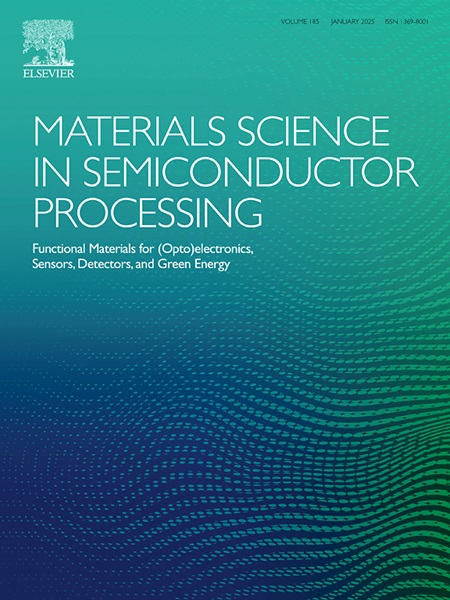Impact of incomplete ionization in presence of interface traps in p-i-n TFET and n-p-n double gate TFET
IF 4.2
3区 工程技术
Q2 ENGINEERING, ELECTRICAL & ELECTRONIC
引用次数: 0
Abstract
This study investigates the impact of incomplete ionization and interface traps on the performance of p-i-n SOI Tunnel Field-Effect Transistors (TFETs) and n-p-n SOI double-gate TFETs, known for their low subthreshold swing and potential for low-power applications, are sensitive to both incomplete ionization of dopants and defects at the semiconductor-oxide interface. This research examines the interaction of these two phenomena and their influence on device sensitivity, focusing on single level and Gaussian trap distributions. Through comprehensive simulations using the Sentaurus TCAD tool, the study evaluates the effects of different trap distributions and doping levels on TFET performance. Results reveal that Gaussian traps exhibit higher sensitivity compared to single level traps, and incomplete ionization is more significant under negative gate-source voltages, leading to a reduction in available carriers. Additionally, temperature variations alter the sensitivity peaks of the devices, indicating that thermal effects influence the behaviour of both traps and incomplete ionization. The findings demonstrate that incomplete ionization and interface traps significantly affect TFET performance, with Gaussian traps posing a greater challenge due to their broader energy distribution. The study provides valuable insights for optimizing TFET designs by accounting for these non-idealities, which can improve device reliability and performance in practical applications. In conclusion, the research contributes to the understanding of incomplete ionization in the presence of interface traps and its implications for TFETs, offering guidance for the development of more efficient and reliable transistor designs.
p-i-n和n-p-n双栅TFET中界面阱存在时不完全电离的影响
本研究研究了不完全电离和界面陷阱对p-i-n SOI隧道场效应晶体管(tfet)和n-p-n SOI双栅tfet性能的影响,它们以低亚阈值摆动和低功耗应用潜力而闻名,对掺杂剂的不完全电离和半导体-氧化物界面缺陷都很敏感。本研究考察了这两种现象的相互作用及其对器件灵敏度的影响,重点研究了单能级和高斯阱分布。通过使用Sentaurus TCAD工具进行综合模拟,研究评估了不同陷阱分布和掺杂水平对TFET性能的影响。结果表明,高斯阱比单能级阱具有更高的灵敏度,并且在负栅极源电压下,不完全电离更为显著,导致可用载流子的减少。此外,温度变化改变了器件的灵敏度峰值,表明热效应影响了陷阱和不完全电离的行为。研究结果表明,不完全电离和界面陷阱会显著影响TFET的性能,其中高斯陷阱由于其更广泛的能量分布而面临更大的挑战。该研究通过考虑这些非理想性,为优化ttfet设计提供了有价值的见解,可以提高器件在实际应用中的可靠性和性能。总之,该研究有助于理解界面陷阱存在下的不完全电离及其对tfet的影响,为开发更高效、更可靠的晶体管设计提供指导。
本文章由计算机程序翻译,如有差异,请以英文原文为准。
求助全文
约1分钟内获得全文
求助全文
来源期刊

Materials Science in Semiconductor Processing
工程技术-材料科学:综合
CiteScore
8.00
自引率
4.90%
发文量
780
审稿时长
42 days
期刊介绍:
Materials Science in Semiconductor Processing provides a unique forum for the discussion of novel processing, applications and theoretical studies of functional materials and devices for (opto)electronics, sensors, detectors, biotechnology and green energy.
Each issue will aim to provide a snapshot of current insights, new achievements, breakthroughs and future trends in such diverse fields as microelectronics, energy conversion and storage, communications, biotechnology, (photo)catalysis, nano- and thin-film technology, hybrid and composite materials, chemical processing, vapor-phase deposition, device fabrication, and modelling, which are the backbone of advanced semiconductor processing and applications.
Coverage will include: advanced lithography for submicron devices; etching and related topics; ion implantation; damage evolution and related issues; plasma and thermal CVD; rapid thermal processing; advanced metallization and interconnect schemes; thin dielectric layers, oxidation; sol-gel processing; chemical bath and (electro)chemical deposition; compound semiconductor processing; new non-oxide materials and their applications; (macro)molecular and hybrid materials; molecular dynamics, ab-initio methods, Monte Carlo, etc.; new materials and processes for discrete and integrated circuits; magnetic materials and spintronics; heterostructures and quantum devices; engineering of the electrical and optical properties of semiconductors; crystal growth mechanisms; reliability, defect density, intrinsic impurities and defects.
 求助内容:
求助内容: 应助结果提醒方式:
应助结果提醒方式:


